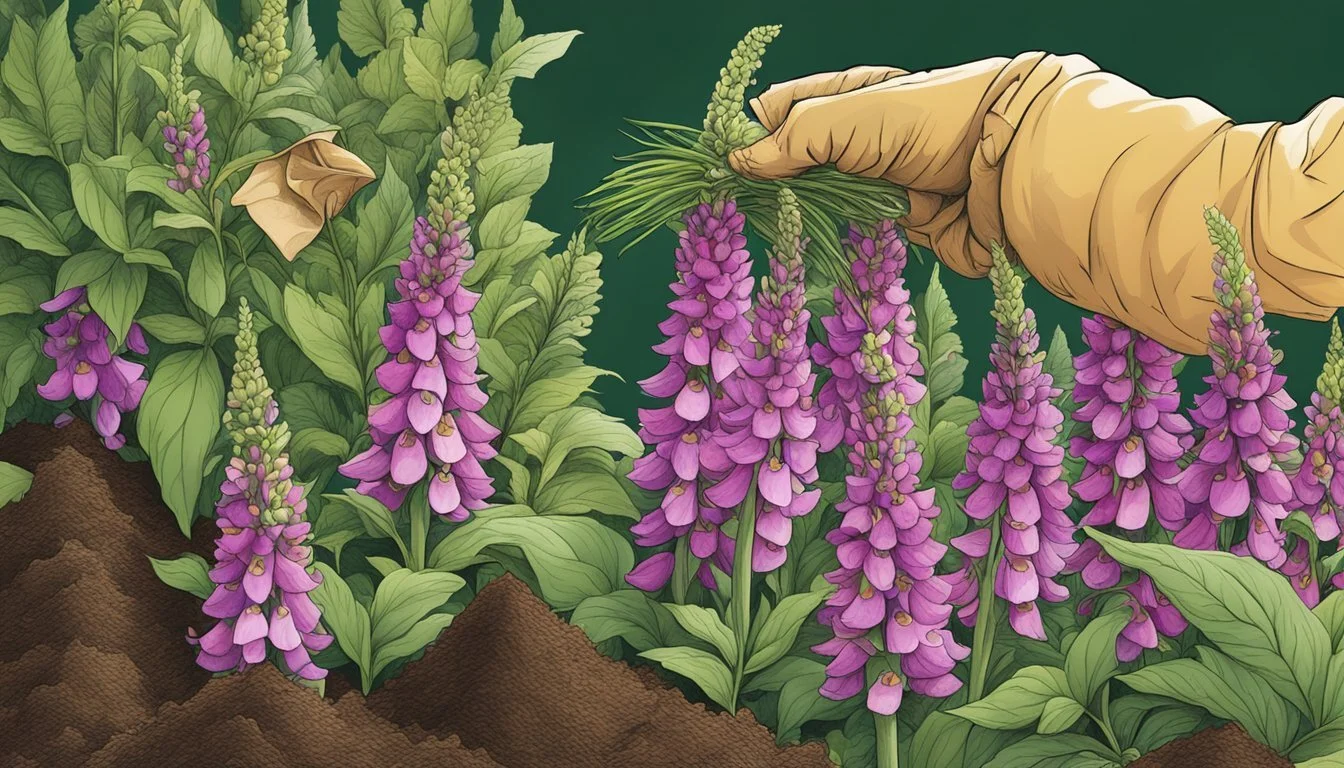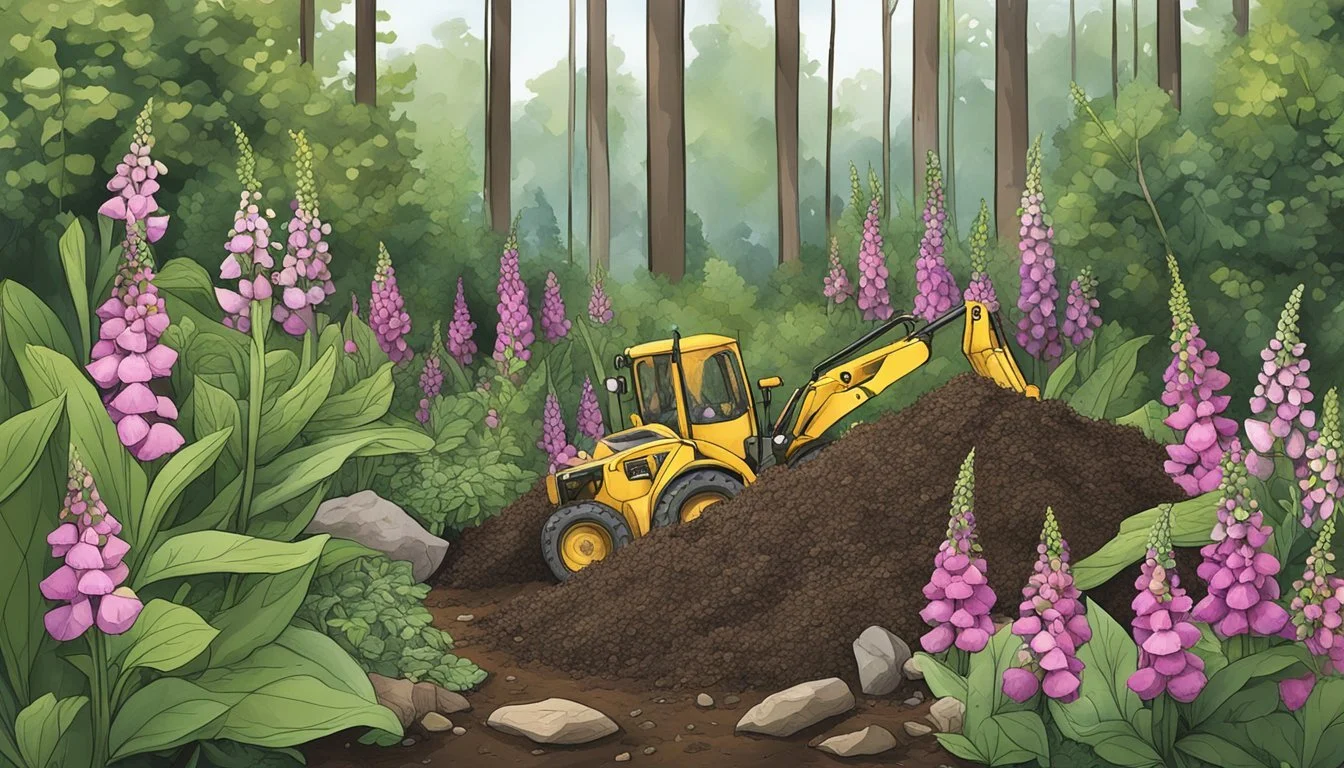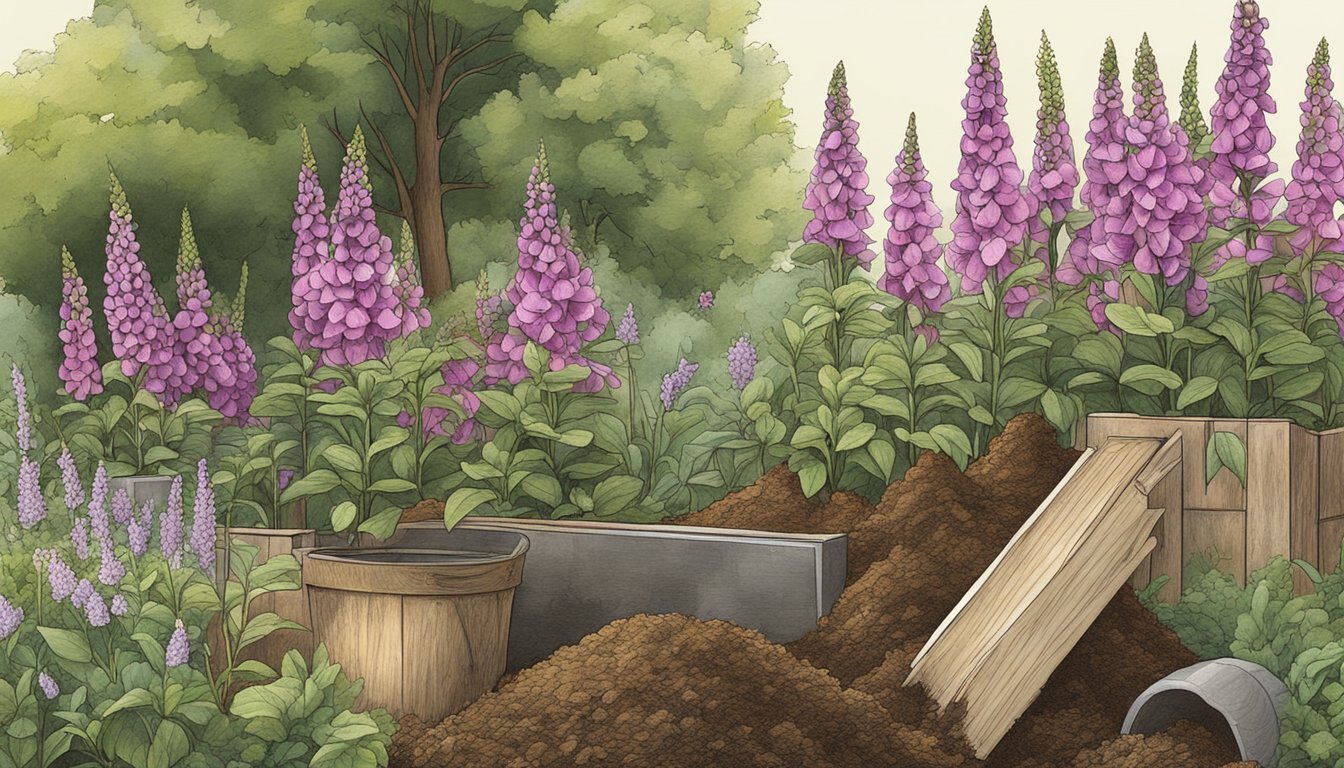Can You Compost Foxgloves?
Understanding Safe Composting Practices
Foxgloves, known botanically as Digitalis purpurea, are a distinctive presence in many gardens, valued for their tall spires of tubular flowers that attract bees and other pollinators. Typically characterized as biennials, foxgloves spend their first year developing roots and foliage, while the second year is dedicated to flowering and seed setting. After blooming, they usually die, but some varieties function as short-lived perennials, offering gardeners a slightly longer display.
When considering the sustainability of gardening practices, composting arises as an essential topic, with many gardeners questioning whether specific plants like foxgloves can be safely added to compost piles. Since the plant material from foxgloves breaks down like other organic matter, they can technically be composted. However, it is crucial to acknowledge that foxgloves contain certain compounds that could influence the composting process and its subsequent use.
It is well-known that foxgloves contain cardiac glycosides which are toxic to humans and animals. While these compounds can break down over time in a compost heap, especially during the high-heat phases of composting, caution is advised. Ensuring that the compost matures adequately allows the breakdown of these toxins, making the compost safer for use in gardens. Gardeners should be particularly mindful when composting foxgloves to prevent any potential risks associated with their toxicity.
Understanding Foxgloves
Before delving into the potential of composting foxgloves, it is essential to understand the botanical nature of these plants, their varieties, and the conditions under which they thrive.
Botanical Profile
Foxgloves, scientifically known as Digitalis, are a group of plants that are classified as either biennial or perennial. They are part of the family Plantaginaceae and are highly recognized for their distinct tubular flowers. The genus name, Digitalis, comes from the Latin word for finger (digitus), referring to the way the flowers easily fit over a human finger.
Varieties and Colors
With several species, foxgloves offer a variety of colors and sizes. The hues of these eye-catching flowers range from purple, pink, white, to yellow. Some of the well-known species include:
Digitalis purpurea: Often purple or pink, growing up to 5 feet tall.
Digitalis grandiflora: Boasting yellow flowers, also known as the yellow foxglove.
Digitalis parviflora: Features small, brownish-red flowers.
Digitalis lutea: Also known as the straw foxglove with small, pale yellow flowers.
Ideal Growing Conditions
Foxgloves flourish in a variety of soil types, as long as the soil is not too dry or waterlogged. They tend to prefer slightly acidic to neutral, and even slightly alkaline soil pH levels. The plants generally grow best when planted in spring or fall and produce vibrant flowers in the spring and summer months. They favor cool climates and a mix of sun and partial shade, where they can grow tall and produce ample blooms.
Cultivation Best Practices
Successful cultivation of foxgloves requires an understanding of proper propagation, planting, and ongoing care. Employing the right techniques can lead to a garden adorned with their characteristic bell-shaped flowers.
Propagation Techniques
Foxgloves can be grown from seeds. Sow seeds indoors in late winter to early spring, or directly in the garden once the threat of frost has passed. For best germination, scatter seeds on the surface of a well-draining soil mix, gently pressing them in, as they require light to germinate.
Planting Guidelines
Transplant seedlings outdoors after the risk of frost is over when they have developed a couple of true leaves. Foxgloves thrive in moist but well-drained soil, with their best growth in loam. Choose a site that offers full sun to partial shade, bearing in mind that in hotter climates, partial shade is preferable to protect plants from intense heat.
Spacing: Plant them 18 to 24 inches apart to allow for proper air circulation and growth.
Depth: Set the transplant at the same soil level it was growing in the container.
Soil pH: Aim for a soil pH that is neutral to slightly acidic.
Containers: If planting in pots, ensure they are sizeable with adequate drainage holes.
Ongoing Care and Maintenance
Regular care is important for the well-being of foxgloves. Keep the soil consistently moist but not waterlogged, mulching around the base to retain moisture and regulate soil temperature.
Watering: Provide one inch of water per week, more frequently in the case of extreme heat.
Fertilizer: Feed foxgloves with general-purpose fertilizer at the beginning of the growing season.
Support: Taller varieties may require staking to prevent them from falling over.
Sunlight: Adjust positioning if potted to ensure they receive the desired amount of light as the seasons change.
Drainage: Whether in-ground or in containers, ensure good drainage to avoid root rot.
By adhering to these cultivation best practices, foxgloves can become a stunning feature in the garden, displaying their impressive height and colorful blooms from early summer into fall.
Composting Foxgloves
Composting foxgloves involves addressing toxicity concerns and adhering to proper composting practices to ensure safety and efficiency.
Feasibility and Safety
Foxgloves contain toxic compounds which can pose risks if directly ingested or improperly handled. Their natural toxicity primarily comes from compounds called cardiac glycosides. Despite their poisonous attributes, once foxgloves undergo the composting process, the risk associated with these compounds diminishes as they break down over time. Microorganisms in a compost pile can degrade many toxic elements, rendering the resulting compost safe for use in gardens.
Key considerations for safety:
Awareness: Knowledge of the plant's toxicity is crucial for safe handling during composting.
Protection: Use gloves when handling foxgloves to minimize skin contact with the toxic sap.
Time: Allow sufficient time for composting; a longer process ensures breakdown of toxic components.
Composting Methodology
The process of composting foxgloves does not differ markedly from composting other garden waste, but care should be taken to ensure proper breakdown.
Gather Materials: Collect foxglove cuttings, ensuring they are not diseased to prevent spreading pathogens.
Cutting Size: Chop or shred the plant material into smaller pieces to speed up the decomposition process.
Balance the Pile: Mix foxgloves with a good balance of 'greens' (nitrogen-rich materials) and 'browns' (carbon-rich materials) to maintain an optimal composting environment.
Ideal composting setup:
Aeration: Regularly turn the compost pile to supply oxygen, which aids in breaking down toxic substances.
Moisture Level: The pile should be as moist as a wrung-out sponge to support microbial activity without becoming soggy.
Size of Pile: A larger heap retains heat better, which can speed up the composting process and further break down toxins.
It is essential to ensure thorough decomposition of foxgloves before using the compost on edible plants, as a precautionary measure to avoid any residual toxicity.
Foxglove Concerns and Considerations
When considering including foxgloves in a compost pile, one must be mindful of their toxicity as well as the various pests and diseases that can affect these plants.
Toxicity and Pet Safety
Foxgloves (Digitalis spp.) contain cardiac glycosides, compounds that are toxic to humans and animals if ingested. As such, all parts of the plant are poisonous and can pose a serious risk to pets and wildlife. The toxic nature of foxgloves should be a primary concern when deciding whether to compost these plants, especially if pets have access to the area.
Pests and Diseases
Foxgloves can fall prey to several pests and diseases, which could potentially be spread to other plants through compost. Common issues include:
Aphids: These pests can weaken plants by feeding on them.
Powdery Mildew: A fungal disease that covers leaves with a white, powdery coating.
Rust: This fungal disease causes orange-brown pustules on leaves and stems.
It is also important to note that foxgloves are generally resistant to deer, which prefer to avoid these toxic plants. However, disease-infected plants should be kept out of compost to prevent the spread of pathogens.
Foxgloves in the Ecosystem
Foxgloves are an integral part of the ecosystem, supporting wildlife interactions and featuring prominently in garden design due to their aesthetic and ecological benefits.
Wildlife Interactions
Foxgloves (Digitalis) play a crucial role by providing a rich source of nectar for a variety of pollinators. They are particularly important for bees, both wild and domesticated, which are attracted to their tubular flowers. Specifically, bumblebees find foxgloves to be an excellent plant as the flower's shape is well-suited to their long tongues, allowing them to effectively retrieve nectar. Moreover, hummingbirds are frequent visitors, benefiting from the high nectar content as well.
As woodland plants that can also flourish in a cottage garden setting, foxgloves contribute significantly to the sustenance of wildlife, creating biodiversity hotspots within their environment. Additionally, the ability of foxgloves to self-seed ensures a continual presence in gardens and woodlands, offering a consistent food source for various creatures year after year.
Foxgloves in Garden Design
Incorporating foxgloves into garden design adds both visual height and biological function. They stand out as vertical elements in flower borders, effectively creating depth and dimension. Renowned gardener Monty Don underscores their value, noting foxgloves as a staple for adding interest to the landscape. Moreover, their stately spikes often become focal points within a garden's composition.
Beyond aesthetic appeal, foxgloves' self-seeding nature provides a dynamic and evolving element to garden design, with new plants often sprouting in various locations each year, offering pleasant surprises to gardeners and a changing tableau for pollinators and garden visitors alike. Their adaptability to a range of conditions makes them an accessible choice for many gardeners, contributing to the overall resilience and vibrancy of the garden ecosystem.
Lifecycle and Reproduction
Foxgloves, with their tall spikes of bell-shaped flowers, go through a distinctive lifecycle beginning with germination and culminating in self-seeding. They are predominantly biennial, meaning their lifecycle spans two years, although some varieties behave as perennials. The reproduction process greatly influences garden ecology by providing opportunities for continual growth and pollinator support.
From Germination to Flowering
Foxgloves typically begin their lifecycle when seeds germinate in late spring to early summer. Seedlings may be started in seed trays with well-draining soil or directly sowed in the garden. The first year is dedicated to establishing a robust foliage rosette. In the following year, the plant transitions to the flowering phase, which mainly occurs in spring or early summer. Deadheading, or the removal of spent flowers, can extend the flowering period and prevent early seed drop.
First Year: Establishment of the leafy rosette.
Second Year: Production of the flowering stalk and blossoms.
Self-Seeding and Spread
Once the flowering period concludes, typically by late summer or autumn, foxgloves produce a profusion of seeds. If gardeners do not deadhead the spent flowers, the plants can self-seed prolifically, leading to new plants the following year. Foxgloves thrive in a variety of soil types, though they favor rich, well-drained soils. They spread easily, which, coupled with their ability to self-seed, allows gardeners to expect an ongoing presence of these plants in their gardens with minimal intervention.
Autumn: Seed pods mature and release seeds.
Self-Seeding: Seeds disperse naturally, often maintaining or expanding the presence of foxgloves in the garden.
With appropriate knowledge of soil, timing, and care, gardeners can foster the natural reproductive cycle of foxgloves to ensure these majestic flowers continue to grace gardens year after year.
Seasonal Foxglove Care
Foxgloves showcase their bell-shaped blooms from spring through early summer and require attentive care as the seasons change to maintain their vibrancy and health.
Spring and Early Summer
Spring marks the beginning of the growth cycle for foxgloves. They thrive in well-draining, fertile soil and will start to display their rose, pink, yellow, or white flowers during late spring. During this period, these perennials require:
Regular watering to keep the soil consistently moist but not waterlogged.
Application of a balanced fertilizer as new growth appears.
As temperatures rise in early summer, mulching helps retain soil moisture and keep the roots cool.
Late Summer and Autumn
By late summer, foxgloves have usually finished blooming. To encourage vigour:
Deadhead spent flowers to prevent self-sowing, if desired.
Reduce watering as the plant prepares for dormancy.
In autumn, or fall, preparation for the cooler months includes:
Dividing the plants if needed for propagation.
Adding a layer of mulch for root protection before the first frost.
Regional Considerations
Foxgloves (Digitalis spp.) thrive across a variety of climatic regions, making them versatile for composting purposes as well. It is crucial to understand the specific needs regarding their successful growth and the implications for composting within different climates.
Growing Foxgloves in Various Climates
Europe: In its native regions like Europe, the foxglove flourishes in a climate that offers cool summers and mild winters. They typically enjoy full sun to partial shade and can handle the light conditions found under deciduous trees. Space them accordingly, as their stems can reach tall heights, which allows them to add structure to garden compost piles with their carbon-rich foliage.
Full Shade vs. Full Sun: While some plants may struggle in full shade, foxgloves are quite adaptable. They prefer dappled light but can also grow in full sun if kept moist. However, in areas with especially hot summers, they will need protection from the intense midday sun, so incorporating them into compost in these regions should be done with consideration to avoid overheating the compost pile.
Summer Growth and Composting: During the summer, foxgloves push out their iconic tall spikes of bell-shaped flowers. After flowering, the foliage can be cut back and added to the compost heap. In composting terms, they are considered 'green' waste, which means they are rich in nitrogen and excellent for balancing out the 'brown' carbon-rich materials.
Remember, foxgloves are biennials or short-lived perennials, and their ability to grow in varying conditions of sun and shade makes them suitable for composting in an extensive range of regions—provided that one considers their light and spacing needs for optimal growth and decomposition.
Advanced Foxglove Topics
Advanced studies and practices in foxglove cultivation present intriguing aspects, such as the deliberate breeding for specific traits and the exploration of historical uses and lore, that may pique the interest of avid gardeners and plant historians.
Breeding and Hybridization
In the realm of Digitalis purpurea, or common foxglove, breeding and hybridization efforts focus on enhancing certain desirable attributes like flower color, plant size, and resistance to pests and diseases. Hybrid foxgloves are often created to produce more vibrant flower spikes or to adjust their growth habits to suit different garden spaces. Through careful selection of parent plants, breeding can yield seeds that carry the genetic potential to grow into diverse and improved offspring.
Traits Targeted for Hybridization:
Flower color: Varying shades from white to deep purple
Growth form: Compact versus tall cultivars
Disease resistance: Enhanced resiliency to common pathogens
Historical Uses and Lore
Foxgloves hold a significant place in history, both in medicinal uses and in folklore. Historically, extracts from Digitalis purpurea have been utilized for cardiac treatments, given their potent bioactive compounds that can influence heart activity. However, due to their toxicity, they must be used under strict medical supervision.
Historical Significance:
Medicinal use: Cardiac medication derived from digitalis compounds
Folklore: Stories often portray foxgloves as having magical properties or being inhabited by fairies.
The lore surrounding foxgloves is rich, imbued with tales of woodland sprites and mystical attributes, often symbolizing both healing and harm. They supposedly have the power to both protect and curse, a dualism that reflects their real-life medicinal benefits and toxic nature.











